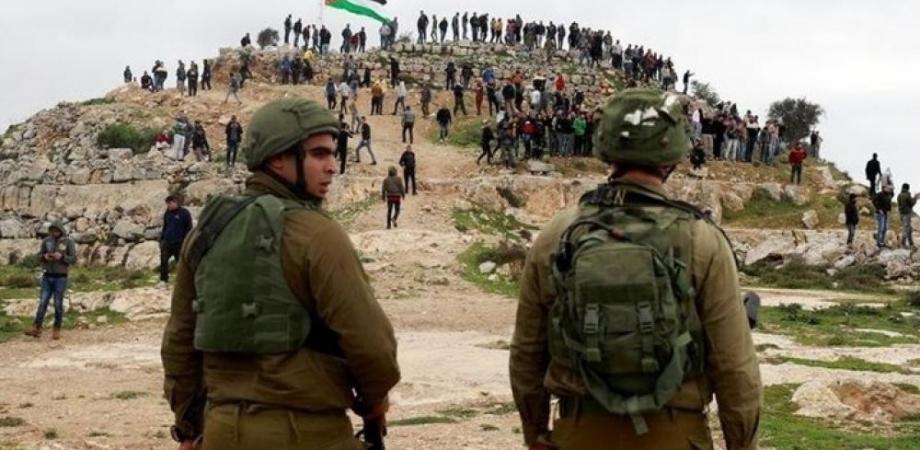The past decade has witnessed an unprecedented acceleration in settlement operations and the seizing of Palestinians' lands in the occupied West Bank and Jerusalem, depending on a systematic Israeli strategy aimed at deporting Palestinians and stealing the rest of their lands.
According to statistics from the Israeli human rights organization B’Tselem, the population increase in West Bank settlements was higher during the year 2020 by 68% than in the occupied territories, in light of the expansion of the establishment of new outposts at the expense of the lands of citizens in the West Bank.
Fight for Survival
Since the Oslo Accord, which classified 51% of Hebron's lands as Area C, and completely under the occupation's control, settlement ambitions have been encouraged in the entire city.
In 1997, the settlement struck the heart of Hebron after an agreement between the occupation and the Palestinian Authority (PA), according to which the city was divided into “H1” areas under full Palestinian control, and “H2” areas under the security control of the occupation.
About 43% of the houses in the Old City of Hebron are empty, and 1,829 of the shops are closed either by Israeli military decisions or as a result of a policy of restrictions and forced displacement of the residents of the area.
In addition, the occupation cut off the town with 21 military checkpoints, equipped with a complete system of electronic gates, surveillance cameras, and inspection devices, through which the town’s residents and visitors pass on a daily basis.
Hajj Awni Abu Shamsia, the owner of a shop that has been closed under military orders since 2000 on Al-Sahla Street, reported to Safa that he tried to remove equipment from his shop, estimated to cost 70,000 Jordanian dinars, but the occupation authorities did not allow him, but rather confiscated and stole them.
Abu Shamsia added that the street is completely empty and the presence of Palestinians in the area is threatened, in light of the continuous restrictions by the occupation soldiers and settlers.
Al-Hajj Abu Shamsia pointed out that the settlers and the occupation "weakened the Palestinian side, but the last battle of the resistance in Gaza re-considered the Palestinians as holders of a right before the occupation and before the world."
Spark of Sheikh Jarrah Neighborhood
With the close connection between the city of Hebron and Jerusalem, fears have been raised that the occupation will seek to copy its plan to displace Palestinians on Al-Shuhada Street in Hebron and apply it to Sheikh Jarrah neighborhood in occupied Jerusalem, according to Alaa Salaymeh, a resident of Sheikh Jarrah neighborhood.
Salaymeh said to Safa that "the occupation forces are trying to impose the same bitter experience of Al-Shuhada Street in Hebron on the neighborhoods of Sheikh Jarrah and Batn Al-Hawa in occupied Jerusalem," noting that "the occupation turned the neighborhood into a closed military barracks, and set up checkpoints at its entrance and prevented the solidarity activists in it."
She noted that the residents of the neighborhood referred their case to the International Criminal Court (ICC), pointing out that they would not rely on the unfair courts of the occupation.
"The case of Sheikh Jarrah formed a spark for the uprising of the Palestinians and their clash with the occupation from northern Palestine to its south," she continued
Salaymeh called on the PA to play its role and to use the available capabilities to help the issue, noting that the occupied East Jerusalem area is considered, according to international laws, to be Palestinian land under the PA control.
Sbeih Mountain
In Nablus, Sbeih Mountain, in the south of the district, has been turned into a field of popular resistance, rejecting the occupation's attempts to build a settlement on the lands of the mountain, whose lands are owned by Palestinian citizens.
Hajj Muhammad Khabisa, an owner of one of the threatened lands in the mountain, said, "The lands of the mountain are for our fathers and grandfathers, and 95% of them are planted with olive trees."
The specialist in settlement affairs, Farhan Alqam, confirmed in his report to Safa that "the recent confrontation against the occupation has formed a positive intervention to repel the Zionist and settlement attack in the Sheikh Jarrah neighborhood, Bab Al-Amoud and in the courtyards of Al-Aqsa Mosque."
Alqam said that "one of the practical results for the confrontation was the halting of allowing settlers to enter the courtyards of Al-Aqsa Mosque for a period of more than two weeks, and the postponement of the decision on the case of Sheikh Jarrah and the Batn Al-Hawa neighborhoods."
He stressed that "the resistance in Gaza made a difference in the battle against settlement."
Also, he believed that the act of resistance had an impact on the American position, which declared the right of the Palestinians to have an independent state within the 1967 borders.
The specialist in settlement affairs pointed out that the statements of the head of the Hamas movement in Gaza, Yahya Sinwar, that the resistance will back Palestinians in the West Bank and Jerusalem "had an impact on reviving the popular resistance to confront the rabid and unprecedented settlement attack."





